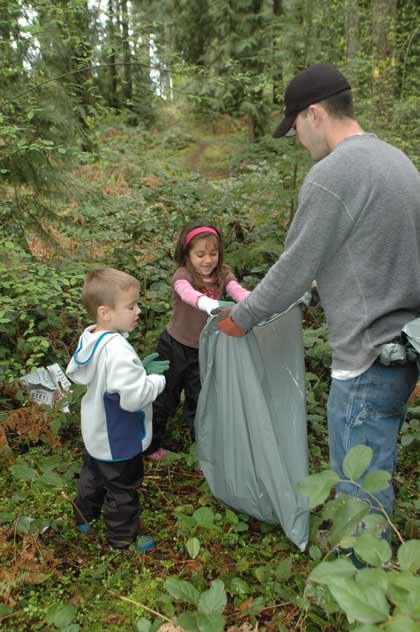Dozens of Bonney Lakers of all ages braved the rain Saturday morning to take part in the city’s Arbor Day/Park’s Appreciation Day, picking up litter at parks around the city and helping to install a new rain garden in front of the public safety building.
The day began at the trailhead for the former WSU demonstration forest with a ceremony to celebrate the fifth straight year Bonney Lake has received a Tree City Award from the Arbor Day Foundation.
After a tree planting, volunteers fanned out through the forest, scouting the trails for litter and hauling out to a dumpster waiting in the parking lot.
Allen Hradil said he has lived in Bonney Lake for more than five years and decided to join this year’s park appreciation day festivities because he felt the need to give back to the city.
“We just wanted to help the community,” said Hradil, who with his two children, Micah, 3, and Evelyn, 6, dodged rain drops and helped clear litter from the forest.
Approximately 40 people helped clear the trails Saturday.
Also on Saturday, Winona Jacobsen was honored with the Robert Ceola Award. The award was started on Arbor Day 2007 in honor of the resident whose name it bears and it is given to a resident who has worked to make the city greener.
Meanwhile, along the Sumner-Buckley Highway, a team of volunteers worked to ready a new rain garden as a demonstration of a new technique to use plants to help filter stormwater instead of just capturing it in storage ponds.
Using a grant from the state Department of Ecology, the city of Bonney Lake worked with designers Marilyn Jacobs and David Hymel to create a small depression fed by stormwater pipes carrying water off of the roof of the public safety building, as well as from runoff of the surrounding driveways. The rain garden uses native plants to help soak up excess water and to help trap pollutants in their roots, preventing the oils from getting into the stormwater system.
The small, landscaped depression is also designed to be dry in the summer, as well as wet in the winter.
“The whole thing is stormwater management,” Jacobs said, “We like to say ‘Where the rain falls, it stays.’”
Jacobs, Hymel and a team of volunteers planted 216 plants on the area and spread wood chips that also help to soak up excess water.
And as the team finished their work and the rains fell, water began to flow through the pipes and into the garden, soaking into the wood chips and around the grasses and berry plants.
“Look,” said Jacobs, pointing to the drains, “It’s doing its job.”



